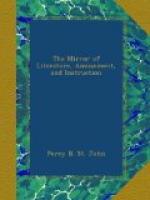* * * * *
THE DIORAMA, REGENT’S PARK
Has reopened with two new views—Paris from Montmartre, (by no means a new, but, perhaps, the best, point of view of the city,)—and the famed Campo Santo of Pisa. The execution of both scenes is calculated to maintain the unique reputation of the establishment. They have the fine effects, the finishing touches, of master-hands.
* * * * *
NEW BOOKS.
* * * * *
THE TRIALS OF CHARLES I.
(With those of some of the Regicides have been prepared for the 31st volume of the Family Library. We suspect the editor to be M. D’Israeli, who has been poring over the records and fingering the dust of the Royal “martyr” for many years past. Our honourable friend, Clavering, of the Metropolitan, in his recollections of the British Museum, long since, says, “there sat D’Israeli, daily extracting from the voluminous M.S. letters of James I. and Charles I.” Whoever the compiler of this volume may be, it must be allowed that, in the form of notes and biographies, he has brought into less than 350 pages a greater collection of interesting incidents connected with his main subject than many writers would have cared to assemble; and he has accordingly produced a work, in every respect, fitted for popular reading. We quote passages from the Execution to the Interment of Charles, but we have not room for the Editor’s very pertinent “Remarks on the Trial.”)
On the morning of his death, Charles, according to the relation of his faithful attendant, Sir Thos. Herbert, awoke about two hours before daybreak, after a sound sleep of four hours. He called to Herbert, who lay on a pallet, by his bedside, and bade him rise; “for,” said the King, “I will get up, I have a great work to do this day.” He then gave orders what clothes he would wear, and said to his attendant, “Let me have a shirt on more than ordinary, by reason the season is so sharp[4] as probably may make me shake, which some observers will imagine proceeds from fear. I would have no such imputation. I fear not death—death is not terrible to me. I bless God, I am prepared.” Soon after the King was dressed, Bishop Juxon came to him, according to his appointment the night before. He remained an hour in private with him, when Herbert was called in, and the Bishop prayed with the King, using the prayers of the church, and then read the 27th chapter of St. Matthew, which so beautifully describes the passion of our Saviour. The King thanked the Bishop for his choice of the lesson; but he was surprised and gratified to learn that it was the lesson for the day according to the calendar.
[4] The day was so piercing
that the king, at the persuasion of
Bishop Juxon, wore a cloak
till the moment of his death.




